Matador Network's Blog, page 612
August 10, 2021
New study shows differences in Gen X, Millennial, and Gen Z travel plans right now
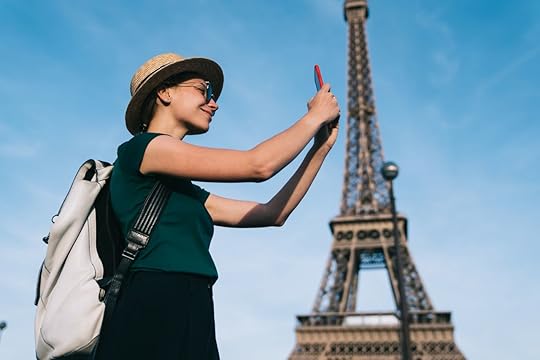
For some vaccinated people, it’s starting to feel like it’s time to dust off that suitcase and get to packing as travel starts to open back up. And statistics show that you’re probably ready to go, though exactly how ready and what type of travel you’re looking to do may depend on your age.
The travel booking platform GetYourGuide conducted a study how Gen X, Millennials, and Gen Z feel about travel. According to the survey, the thing that people are most excited about as pandemic restrictions ease is travel — at least more so than eating in restaurants, attending parties, and going to bars and clubs.
More than 70 percent of total respondents have already planned their vacations. Sixty-one percent of Gen Xers said they’re staying domestic, while 20 percent said they’re looking international. On the other side, 51 percent of Gen Zers are planning international trips versus 37 percent who stated they’re planning a trip in the US. Only 35 percent of Millennials surveyed are seeking out international travel, though 48 percent are planning domestic travel.
The study also asked where people are planning to travel. The top domestic destinations include New York City, Miami, Los Angeles, San Diego, and San Juan. Outside of the US and its territories, Dubai, Cyclades, and Paris are the most popular. More than a third of Gen Z and Millenials have been in a different city in the past month, while Gen Xers are more cautious, with a third not having traveled to another city for more than a year.
Gen Z (57 percent), Millennials (54 percent) and Gen X (55 percent) are prioritizing safety and putting outdoor activities in demand. But across the board, people in each generation can agree that the most annoying part of travel is figuring out how to pay for it. Sixty-three percent of Millennials are willing to pay someone to figure out all of the arrangements and excursions for them. The majority of Millennials are also stashing away more money for their excursions, spending between $51 and $100 per person for experiences each day, while only 15 percent of Gen Z and 14 percent of Gen X are budgeting that amount.
Whatever your travel plans are, it’s time to get moving in the safest ways we can.
The post New study shows differences in Gen X, Millennial, and Gen Z travel plans right now appeared first on Matador Network.
There are two types of Italian coffee drinkers. Which one are you?

In Italy, the phrase prendiamo un caffè – “let’s get a coffee” – is loaded with meaning. From the macchiato you throwback at an opulent bar in Milan to the espresso you savor al fresco in Palermo, getting a coffee in Italy involves engaging with a well-established set of cultural and culinary regional practices.
Coffee arrived in Italy in the late 17th century, entering Venice from the Ottoman Empire. When Venice’s first cafe, Caffè Florian, opened in 1720, coffee consumption became popular among wealthy intellectuals. It wasn’t until the early twentieth century — relatively recently, in fact — that coffee became more widely accessible.
In 1905, Luigi Bezzera and Desiderio Pavoni, both mechanics from Milan, teamed up to improve on the steam-powered coffee machine that launched at Turin’s General Exhibition in 1885. The improvements Bezzera and Pavoni added enabled the water to get hotter and the machine to produce more pressure when brewing. While their machine didn’t produce espresso by modern standards, coffee could be prepared faster than ever before.
This quick-serve style of coffee arrived alongside the industrial revolution. Coffee transformed into an affordable indulgence that exhausted workers could grab running to work. But it took Italy’s economic boom following the second World War for espresso as we know it today to embed itself into Italian culinary culture.
While American money from the Marshall Plan was helping to reboot the Italian economy and increase wages, Milanese engineer Achille Gaggia was building a lever-operated horizontal espresso machine. Not only did the horizontal positioning enable drinks to be briskly passed from server to customer, the machine also exerted nine bars of pressure. This pressure resulted in a frothy cap on top of the coffee, known as crema. Modern espresso had arrived.

Photo: Henk Vrieselaar/Shutterstock
If you’ve visited Italy and tried to order a post-lunch cappuccino, you probably are already familiar with the coffee rituals and routines that Italians revere. Alongside these rituals sit unique recipes, roasters, and drinking styles, all of which vary across Italy’s twenty-one different regions. Being fluent with these nuances is key to enjoying your caffè all’italiana (Italian-style coffee).
Before we delve into these regional traits, we need to establish the coffee protocols that are universal throughout Italy. First, call it caffè, not espresso. Second, milk is reserved for morning drinks – you’ll struggle to find an Italian drinking a cappuccino as an afternoon pick-me-up (bad for the digestion, they’d say). You’ll pay less to drink standing at the bar, as the government controls the price of an espresso to keep it affordable (a 2021 survey says the price of a standard caffè tops out at 1.21 euro in Trento). Drinking at the bar is also a social experience; Italians see coffee as an excuse to chat. This ritual starts in the morning, when people catch-up with friends over colazione al bar (breakfast at the cafe), then continues throughout the day with regular breaks for a pausa caffè (coffee pause).
Coffee in Northern Italy
Photo: Kirk Fisher/Shutterstock
Head to the North – which for the purposes of this article we’ll say extends as far south as Rome – and you’ll be among the country’s most illustrious coffee cities. There are internationally renowned roasters in Turin (Lavazza) and Trieste (Illy), while opulent, storied cafes dot cities from Florence to Bologna.
No matter where you go in the North, there are some key commonalities between the styles of coffee you’ll encounter and ordering strategies you’ll need to get your perfect drink.
The majority of cafes serve only one brand of coffee. In the North it’s frequently Illy or Lavazza, though also common is Caffè Vergnano, which comes from a town outside Turin. While these are reliable options, you should also seek out smaller, regional roasters to sample more unique flavors. Each city tends to boast their own hyper-local roaster, from Caffè Janko in Pavia (Lombardy) to Spinetta in Valdobbiadene (Veneto). Also notable are Caffè del Doge, tucked behind the Rialto Bridge in Venice’s San Polo district, Rome’s Sant’Eustachio near Piazza Navona and Bergamo’s third-wave roaster Bugan Coffee.
These northern roasters tend to favor Arabica coffee beans, which produce a drink with a thick body. The aroma can range from floral to caramel notes, depending on how long the beans are roasted.

Photo: Kcuxen/Shutterstock
Arabica coffee provides an ideal canvas for dessert-worthy drinks. For a chocolate-dusted pick-me-up, head to Milan and order a marocchino, which mixes espresso and steamed milk with a generous dusting of cocoa powder. Turin’s bicerin layers espresso, hot chocolate and milk with a spoonful of whipped cream on top – you can find it across the city, or head to its source Caffè Al Bicerin. Complete your chocolate-coated coffee tour in Padua, where the historic Caffè Pedrocchi serves espresso blended with mint cream and cocoa powder.
There are also more moderately flavored drinks to sample. When in Trieste, opt for a capo in b. Served in a small glass, the drink has more milk than a macchiato but less than a cappuccino. A similar formula is available in the Veneto by asking for a macchiatone. If you’re trying to pass as a local near Milan, you can order your cappuccino by requesting a cappuccio. And for a post-dinner pick-me-up, Livorno in Tuscany offers the potent ponce (punch), which combines espresso, rum, sugar and a lemon peel.
For breakfast around Milan or Turin, order a brioche. This croissant-shaped pastry can be eaten plain, or vuota (empty), but is more likely to come filled with sweet options like crema pasticceria (pastry cream), marmellata (jam, typically apricot) or gianduia (or its name-brand equivalent, Nutella). And if it’s dessert for breakfast you’re craving, seek out bomboloni, sugar-dusted doughnuts filled with pastry cream, or a veneziana, a cream-filled pastry most commonly found around Milan.
Coffee in Southern Italy
Photo: AP_FOOTAGE/Shutterstock
Once you head south of Rome, coffee flavors and rituals transform. Broadly speaking, southern coffee roasters tend to appreciate Robusta beans more than they do in the North. This quick-growing, hearty coffee varietal has a strong, bitter taste. The presence of robusta in the coffee gives the area’s drinks a distinct bittersweet tinge.
Many people choose to accentuate robusta’s flavour by ordering a caffè ristretto, or a restricted coffee. In comparison to a standard caffè, caffè ristretto is made by letting water pass more quickly through the coffee grounds during brewing. While this results in a smaller overall quantity of liquid, the flavour is more concentrated. The resulting coffee is also lower in caffeine since the water has less contact time with the grounds during which to extract it. Most people sweeten their caffè ristretto with sugar.
Naples should be your first stop. Start by popping into a postage stamp-sized bar on Spaccanapoli – a collection of streets splits the historic center in two. Inside, you’re likely to find locals trading quipps about soccer over a caffè al volo (coffee drunk on the run). From there, walk over to Caffè Gambrinus, whose belle epoque interior has hosted leading Italian intellectuals. Splurge on table service to sip coffee elbow-to-elbow with well-heeled locals savoring baba au rhum, Naples’ favorite cream-stuffed, liquor-soaked pastry.
This dichotomy of the grand cafe and the casual bar permeates southern Italy. In Palermo you can bounce between wood-clad Antico Caffè Spinnato and trendy bars in the seafront Kalsa district. Cosenza’s (Calabria) Gran Caffè Renzelli opened in 1803, while in Lecce (Puglia) the cafe Doppiozero weaves together new American cuisine with Italian coffee rituals. And in Bari (Puglia), Martinucci serves traditional pastries among modern decor.
Both types of cafe offer an extensive array of one-of-a-kind, regional drinks. In summer, you can sample everything from a simple caffè sul ghiaccio (espresso over ice) to a caffè shakerato (espresso shaken with ice, milk and sugar). While these are available at bars throughout the south, there are a few more drinks that merit a detour. Head to Lecce to try the city’s iconic caffè leccese, which swaps the simple syrup in a shakerato for almond syrup. And in Sicily, it’s acceptable to order a granita al caffè (sweetened shaved ice with espresso and cream) all day long.

Photo: Andrei Molchan/Shutterstock
No matter what drink you choose, you’ll want to sample the region’s pastries alongside your coffee. While many of the breakfast pastries have the same crescent shape as their northern counterparts, in the South they’re referred to as cornetti. Order a brioche and you’ll receive a yeasted roll, sprinkled with sugar. Like in the North, you can find cornetti with many fillings, but pay special attention to those filled with regional specialties, such as ricotta or pistachio cream.
Southern pastries extend beyond cornetti. In Puglia, sample a pasticciotto. These ingot-shaped cakes combine a thick pasta frolla (shortcrust pastry) exterior with a filling of crema pasticceria, which can be studded with candied cherries or citron. Occasionally you’ll find slices of crostata (tart), slick with apricot jam. And you can even opt for a sfogliatella, a Neapolitan favorite. These can be made either riccia – which involves filling an ultra-flaky pastry with cream – or brioche – stuffed with the likes of cream, chocolate or Nutella. 
The post There are two types of Italian coffee drinkers. Which one are you? appeared first on Matador Network.
Mexico City’s newest exhibition immerses you in the life and works of Frida Kahlo

Matador Network will be taking travelers to Mexico City and Oaxaca from October 24 to 30, 2021. Venture into the cultural heartland of two of Mexico’s most celebrated cities and join in the excitement of the days leading up to the Day of the Dead festivities! For more details, check out Matador Trips.
An artist as dynamic as Frida Kahlo deserves to have her work showcased in an equally bold setting. Mexico City’s newest exhibition, “Frida: La Experiencia Inmersiva,” lives up to the task.
The installation opened in Kahlo’s hometown last month in celebration of her would-be 114th birthday. Part music and light show, part living diary, and part interactive experience, the exhibition is the latest in the immersive art trend that garnered traction in the past couple of years with the wildly successful launch of the traveling “Van Gogh Alive” exhibit.

Photo: Frida Inmersiva/Facebook
According to Cocolab, the multimedia experience brand that produced the show’s visual effects, “Frida is an immersive, multi-sensory experience that takes the work of artist Frida Kahlo and presents it on a monumental scale accompanied by music, scenography, sculpture, interaction, and digital animation.”
A 35-minute light show illuminates many of Kahlo’s most moving works, including “The Two Fridas” and “The Broken Column.” In total, the installation uses 90 projectors and 50 speakers to breathe new life into the artist’s vision.

Photo: Frida Inmersiva/Facebook
Also included in the exhibition are interactive displays such as “Free Stroke,” which invites visitors to create digital masterpieces of their own, and a “Fantastic Creatures” game room that lets visitors select the subjects from Kahlo’s work that they most identify with. Even the bones of the exhibition space honor the artist’s genius, with thoughtful touches like textured curtains, visuals projected on the floor to mirror the artworks on display, and walls designed to disappear to make the installation feel limitless and larger than life.
“Frida” also immerses visitors in Kahlo’s life. The exhibition is soundtracked by Spanish musicians the artist loved, and it includes narration from her personal journals and letters. This allows visitors to “get to know Frida’s paintings, but with a little bit of familiarity and intimacy,” Kahlo’s great-grandniece Mara de Anda told Agence France Presse. “I believe that Friday was very avant-garde and modern, so this fits perfectly. She was a woman ahead of her time.”

Photo: Frida Inmersiva/Facebook
According to Spanish news organization EFE, Anda also expressed her family’s hopes that the installation will help viewers get to know the woman behind the artwork, “not the Frida who suffered, but the one we know and the one we love.”
This hope reflects the nature of Kahlo’s work. Famous for her self-portraits, Kahlo’s portfolio reads like an autobiography, chronicling her life as a woman, an artist, an influential figure, a person with illnesses and disabilities, and the wife of fellow artist Diego Rivera, whose romance with Kahlo was notoriously complicated.

Photo: Frida Inmersiva/Facebook
“Frida: La Experiencia Inmersiva” is on display every Tuesday through Sunday in the Frontón México entertainment center by Alameda Central, the oldest public park in Mexico City and one that’s fittingly ringed by several must-see museums, including the Museu Nacional de Arte, Museu de Arte Popular, and Museo Mural Diego Rivera. Art-loving travelers in the Mexican capital can experience all of the above on a single outing, then head to La Casa Azul, or Blue House, a museum dedicated to Kahlo housed in the home she once shared with Rivera.
Tickets to the exhibition range between $14 and $18, and shows start on the hour from 10:00 AM to 7:00 PM. For optimal immersion, visitors can download the Frida app, which syncs with the audio-visual performance and offers more in-depth background on the artist and her works.
For US-based Frida lovers, “Frida Kahlo: Timeless,” an exhibition displaying 26 of her paintings, will be taking place in Chicago until September 6, 2021. 
The post Mexico City’s newest exhibition immerses you in the life and works of Frida Kahlo appeared first on Matador Network.
This road trip will take you to the most wish-listed Airbnbs in the Midwest

Airbnb compiled its report of the most wish-listed stays in every US state so it’s time for a road trip with some epic accommodations. This road trip that connects the most wish-listed Midwest Airbnbs starts in North Dakota and heads south before turning north again and then back south, a rollercoaster of a road trip that’s even better than the crazy rides at Cedar Point.
Here is a map covering the route of this itinerary:
Lamppost 15 — Bismarck, North Dakota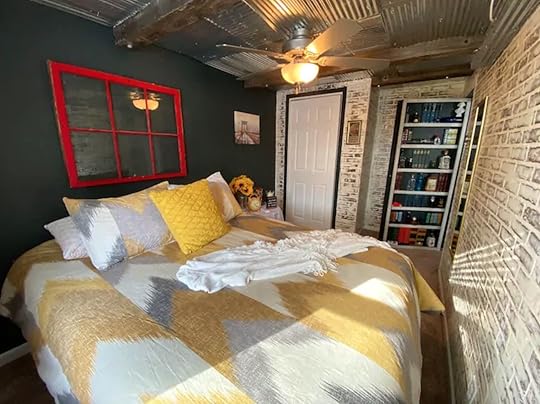
Photo: Airbnb
Lamppost 15 is everything you want in an Airbnb. It’s affordable, has enough room for a small crew, and is located near the commercial center of Bismarck. You can escape to attractions including Fort Abraham Lincoln State Park or a Lewis & Clark Riverboat Cruise. Or you could hit the Missouri River on your own tubes or kayaks. We wouldn’t blame you if you booked an extra night to try all them, leaving time, of course, to lounge around Lamppost 15 and challenge your travel partners to a round on the Ms. Pac Man machine.
Six guests, two bedrooms
$98 per night
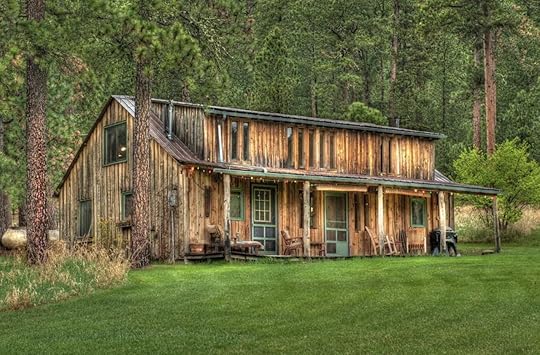
Photo: Airbnb
South Dakota is the most underrated US state for its ease of access to incredible hiking and outdoor recreation. To spend as much time as possible outside during your time in South Dakota, book a night at the Cabin at Green Mountain. Here, just outside the mountain town of Nemo, you can hike and stargaze and porch hang to your heart’s content. You’ll also be close to Rapid City, Sturgis, and the Black Hills, including their famed monuments.
Six guests, two bedrooms
Price: $252 per night
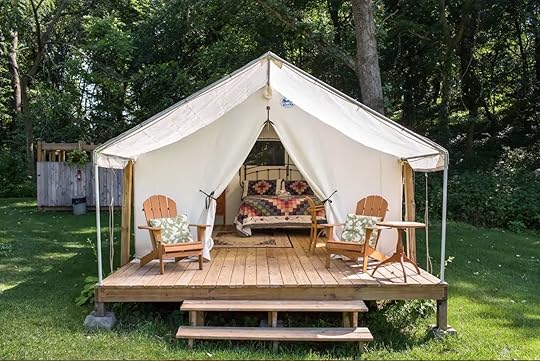
Photo: Airbnb
Of course, no Midwest road trip is complete without at least one night in a tent. The Lazy Oaks Glamping site is set up for success with a spacious tent on an elevated platform, complete with a queen-size bed and a patio for lounging. By night you’ll doze to the call of bullfrogs and the songs of owls. By day you’ll explore the 11 acres of private land and the surrounding countryside.
Two guests, one bedroom
Price: $71 per night

Photo: Airbnb
This cabin retreat outside Tonganoxie, Kansas, includes a tree-hung hammock and an outdoor campfire area, and all the fixins’ of a good ole’ fishing cabin that got a luxurious makeover on the inside. It’s rustic yet comfortable, simple yet complete. The property has hiking trails, axe throwing, and even a labyrinth to keep you occupied. You’ll also have the option to participate in any activities happening at the adjacent retreat space, which could include anything from yoga to a heated chess tournament, depending on the group in residence.
Four guests, one bedroom
Price: $96 per night
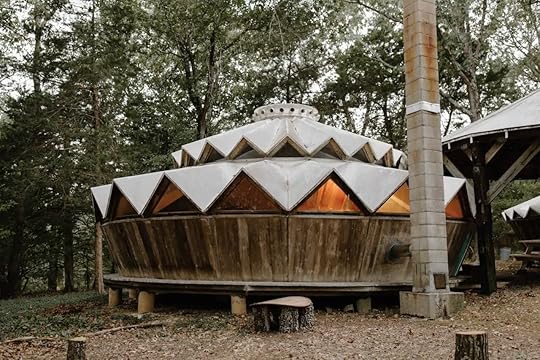
Photo: Airbnb
Nobody ever said all yurts have to play by the same rules. The most wish-listed Airbnb in Missouri is a wood-framed yurt whose top more resembles the white-capped peaks of the Rockies than it does that of a Central Asian traditional dwelling. This is to your advantage, as the accommodation is both warm and cozy, without sacrificing its rustic charm. You’ll be surrounded by the Ozard forest and all the tranquility therewithin.
Six guests, one bedroom
Price: $150 per night

Photo: Airbnb
This cabin sums up everything that the most wish-listed Midwest retreat should be. It’s surrounded by a forest with plenty of deck space; wildlife sightings are common and diverse; and the home is a great place to prepare a home-cooked meal. The listing also touts the accessibility to hiking and golf. Though with the onsite library and fireside reading space, this spot is the perfect point in the trip to simply cozy up with a book and let the logs crackle.
Sixteen guests, six bedrooms
Price: $941 per night
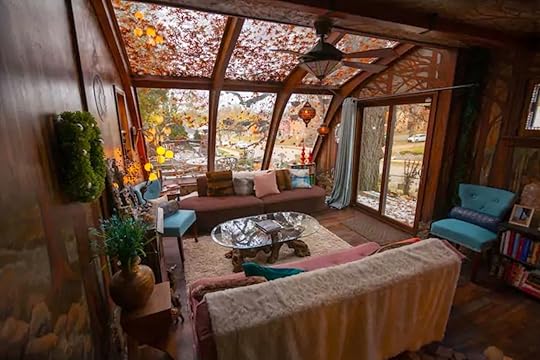
Photo: Airbnb
For being inside a major metropolitan area, the Wolf House studio sure feels remote. Walking into the living space is like entering a new world. You’ll feel like a hobbit among the rocked walls and ceilings and murals reminiscent of Middle Earth. Should you decide to venture out, the Minneapolis Arts District is just outside the door — perhaps justifying the unique artisanal approach that makes this property among the most wish-listed Midwest Airbnbs.
Four guests, one bedroom
Price: $214 per night

Photo: Airbnb
This property perfectly encapsulates the modern take on off-grid living. Remote and self-reliant, yes, but also comfortable, inspiring, and architecturally beautiful. You’ll really feel a part of nature here. A standalone sanctuary of wild awesomeness, this property in the Off Grid Inn complex is an ideal escape from the hustle and bustle of even the smallest of towns. You can hike or snowshoe, depending on the season. No matter when you come, brewing up a pot of coffee and gazing through the bay window into the forest beyond is always in order.
Three guests, one bedroom
Price: $271 per night
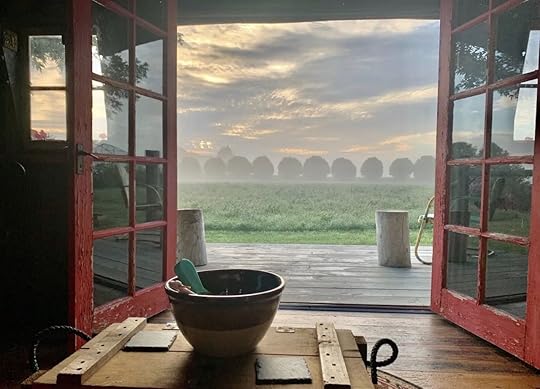
Photo: Airbnb
The coffee view from Ryan’s Place Cabin is the best in the Midwest — open the doors to gaze out and you’ll feel as though you’ve awoken to the Serengeti Plains right here in the middle of Illinois. The Rhymer Nature Preserve is nearby, as are more local fruit and cheese vendors than you could hope to visit in one trip here. The spot was built in 1865 and retains its historical charm, albeit with modern conveniences and a high level of comfort.
Two guests, one bedroom
Price: $95 per night

Photo: Airbnb
From the outside, Birdsong looks much like many other large barns converted into cozy retreats on Airbnb. It’s the inside that separates this incredible property from the rest. It’s perfectly furbished with a hot tub, modern kitchen, and spacious living area. There’s a pool table, reading room, and bedrooms that gaze upon open pastures. And while the hot tub takes all the glory, it’s actually the jacuzzi tub indoors that is the real hero of relaxation here.
Six guests, three bedrooms
Price: $264 per night
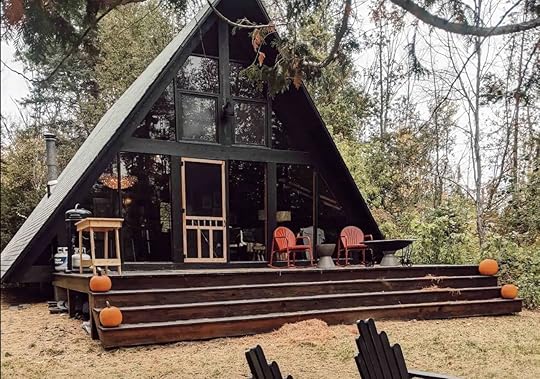
Photo: Airbnb
There are two types of people in this world. Those who wish they lived in A-frame, and those who are lying (ok, technically there’s a third type, those who actually live in one — but these are less actual people than they are gods amongst mere mortals). This picturesque A-frame is in northern Michigan’s hill country, with lake activities at Mullet, Black, and Burt Lakes nearby as well as the state’s too-often-overlooked ski country.
Four guests, two bedrooms
Price: $585 per night
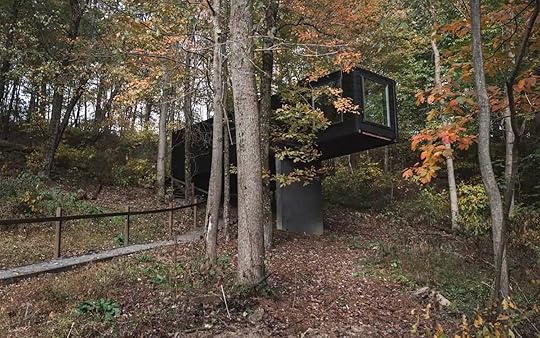
Photo: Airbnb
This modern take on a treehouse is a far cry from those of our childhood dreams. The Box at Treehouse Village is elevated with the surrounding Aspens and outfitted with the niceties of a luxury retreat. This spot is the perfect end to a road trip across the most wish-listed Midwest Airbnbs. Gaze out from the treetops at the surrounding hillside, raising a drink to the epic journey now behind you. 
Four guests, one bedroom
Price: $182 per night
The post This road trip will take you to the most wish-listed Airbnbs in the Midwest appeared first on Matador Network.
You could be a part of NASA’s next Mars mission

NASA is holding a once-in-a-lifetime opportunity for all you space enthusiasts out there. It’s taking applications to send four astronauts to live on Mars for a year. According to its website, to prepare for the real-life challenges of future missions to Mars, NASA will study how these individuals react under the rigor of a long-duration, ground-based simulation.
This Crew Health and Performance Exploration Analog mission will send four astronauts to live and work inside the Mars Due Alpha. A 3D-printed, 1,700-square-foot module made by ICON. While living in this habitat, astronauts will experience simulated challenges of a mission to Mars like resource limitations, equipment failure, communication delays, and other environmental stressors.
“The analog is critical for testing solutions to meet the complex needs of living on the Martian surface,” said lead scientist Grace Douglas, for NASA’s Advanced Food Technology research effort at the Johnson Space Center in Houston. “Simulations on Earth will help us understand and counter the physical and mental challenges astronauts will face before they go.”
Other tasks will include simulated spacewalks, virtual reality robotic controls, exchanging communications, and other scientific research. To participate, candidates must meet NASA’s strict requirements:
Participants must be healthy, motivated US citizens and permanent residents who are non-smokers and ages 33 to 55. They must be proficient in English to communicate between the crew and mission control.Participants must have a master’s degree in a STEM field (engineering, mathematics, or biological, physical, or computer science) from an accredited institution with two years of professional STEM experience or a minimum of 1,000 hours piloting an aircraft. Participants who’ve completed two years toward a doctoral program in STEM or military officer training bachelor of science in a STEM field may also be considered.Participants have until 5:00 PM CST on Sept. 17, 2021, to submit their application.For more information on applying, qualifications, and the application process, you can visit NASA’s website. For more information on the Mars analog mission, visit here. 
The post You could be a part of NASA’s next Mars mission appeared first on Matador Network.
YETI debuted a new color collection and it’s perfect for fall adventures

YETI is a household name among those serious about outdoor exploration. If you’re venturing into the woods for a long camping weekend or hiking your first Fourteener, good luck doing it without some YETI gear in your arsenal. Luckily, YETI released three new color collections just in time for the fall adventure season.
The Highlands Collection is inspired by the rich and rugged terrain of the Scottish Coast, giving you yet another reason to hit the trails. The Harvest Red Collection is inspired by the sweet fruits of fall, defined by its rich berry and red color tones. By contrast, the Sharptail Taupe Collection has more muted colors, inspired by the bronzed prairie in Big Sky Country. Products in each collection, from coolers to backpacks, are equipped with YETI’s patented durability and utility.
Whether you’re heading to the mountains or forest, taking a long-haul vacation, or hitting the beach, there’s something for every type of adventurer. Here are some of our favorite pieces from each collection. 

Photo: YETI
Hopper Backflip 24 Soft Cooler — $299.99
Rambler 14 oz. Mug — $29.99
Daytrip Lunch Box — 79.99

Photo: YETI
Tundra Haul Hard Cooler — $399.99
Crossroads 29” Luggage — $499.99
Rambler 26 oz. Bottle with Chug Cap — $39.99

Photo: YETI
Rambler 18 oz. Bottle with Chug Cap — $29.99
Rambler 10 oz. Lowball with Magslider Lid — $19.99
Rambler 10 oz. Tumbler with Magslider Lid — $19.99
The post YETI debuted a new color collection and it’s perfect for fall adventures appeared first on Matador Network.
You don’t know the cheesy joy of queso’s original recipe until you visit El Paso

All hail queso, one of the most omnipresent and beloved dishes in Tex-Mex cuisine. This mouthwatering dip of melted cheeses and chiles runs through the veins of most Texans. In the decades I’ve spent living away from Texas in five other states, queso has remained the gastronomic security blanket I could always make, and was the centerpiece of every family gathering. I’d grab a chip and dunk it in queso before I gave anyone a hug.
Simplicity is at its core: Take a can of Ro-Tel green chiles and tomatoes and a block of Velveeta. Heat it in the microwave for a few minutes or a slow cooker for a few hours and voila! You have a halftime winner. It’s a recipe so easy you could send it over text. Try to change it and you no longer have queso, just a poor imitation. Or so I thought.
El Paso, Texas, has an entirely different take on the processed American cheese and canned vegetables standby. My family knew the so-called classic recipe that’s been passed down through three generations (the one printed for all to see on the back of a Ro-Tel can). But, through years of meals in El Paso, I discovered our family recipe might not be so classic.
El Paso queso is richer and doesn’t use American cheese as the base. It’s delicious, but so divergent from what I knew to be queso. So is the recipe on the back of the can original, or does a truly Texas take on queso actually come from the innovators in El Paso?
Where queso originally comes fromWe may never know who created the first recipe, but Texas food writer Lisa Fain pinpoints the El Paso region as the likely source in her book Queso! Early iterations of queso used Mexican white cheeses and fresh chiles that were only available during the growing season.
Queso’s base shifted in the mid-20th century when processed American cheeses, like Velveeta, were more widely produced and marketed as an easy melting product with a smooth taste.
Ro-Tel, a produce company started in the south Texas town of Elsa in 1943, began selling pre-mixed cans of green chiles and tomatoes. The two necessary ingredients were there, all they needed was to be combined. In 1949, according to Eater, Ro-Tel printed a recipe using its product. Lady Bird Johnson listed the canned ingredient as the secret to her queso when she was the second lady in the White House in 1963. From there, it took off even outside of Texas.

Photo: Warren Price Photography/Shutterstock
The recipe that swept the nation never caught on in west Texas where El Paso is located, however. In an interview with Texas Monthly, Lisa Fain said that, “The queso that you find in El Paso is very similar to the original incarnation of what chile con queso was described as.” Turns out, the El Paso version of queso I thought was a low-rent derivative of a family recipe turned out to be more authentic.
The El Paso recipe for quesoThe cheeses and overall texture set El Paso queso apart from the Ro-Tel recipe I know and love. Asadero, chihuahua, and monterey jack cheeses are the typical base ingredients, which create a gooey mouthfeel rather than velvety or chunky one. It’s served with tortillas and tostadas for dunking instead of tortilla chips in a way that’s similar to fondue.
Of course, any queso wouldn’t be the same without chiles. Most queso in Texas is made with canned chiles and tomatoes. But, with New Mexico’s famous chile-growing Hatch Valley just an hour north, roasted long green chiles take center stage in El Paso. The earthy taste with a delicate kiss of heat makes Hatch Valley chiles mouthwatering without being eye-watering. Onions and tomatoes round out this rustic yet elegant dish.

Photo: Julio’s Mexican Food/Facebook
Some local restaurants can’t resist putting their own spin on the classic El Paso queso. Fire up classic queso with the cheese flambéed or seared and you have queso flameado. Add savory chorizo and you’ll taste the delectable queso fundido. You can find all of these ingredients on the ranch or at the market.
But what of the Ro-Tel and Velveeta queso? I still love it like I love a local taco joint at midnight when I want comfort over authenticity. But that queso takes its cue from the El Paso original. Without El Paso’s heritage of cheese and chiles, every Texan’s family gathering or football party would be just a little less warm.
Where to try to best queso in El Paso
Photo: L & J Cafe/Facebook
L & J Cafe: Ready to take a dip into queso’s history? Any visit to El Paso must involve a pilgrimage to L & J cafe, the famous fourth-generation-run restaurant that’s affectionately known as “The Old Place by the Graveyard.” Three generations of my family have gathered there for the city’s best enchiladas, and it was the first place that tipped me off to El Paso’s queso legacy. Try the queso fundido for a twist on the classic recipe.
Where: 3622 E Missouri Ave, El Paso, TX, 79903
Julio’s Mexican Food: This restaurant is a heavyweight contender for the best Mexican food in El Paso. It’s been around nearly as long as L & J, but it started across the border in Juárez. Loyal to tradition, the restaurant claims to use the same recipes since 1944. In addition to the knockout queso, it’s my favorite spot for chiles rellenos.
Where: 8050 Gateway Boulevard East El Paso, TX, 79907
Kiki’s Mexican Restaurant: Head here for a more casual, homestyle lunch or dinner. Be sure to order a queso and a bowl of caldillo, a hearty Mexican beef stew.
Where: 2719 N Piedras St, El Paso, TX, 79930
Rosa’s Cantina: Located right on the Rio Grande, this is indisputably the most famous bar in El Paso — though you’d never know that from its humble appearance. Loved by locals and travelers, no trip to west Texas is complete without hitting Rosa’s Cantina at least once.
Where: 3454 Doniphan Dr, El Paso, TX, 79922

The post You don’t know the cheesy joy of queso’s original recipe until you visit El Paso appeared first on Matador Network.
Watch a typhoon take Yayoi Kusama’s iconic ‘Pumpkin’ sculpture into the sea

On August 9, Yayoi Kusama’s “Pumpkin” art piece was knocked loose from its iconic spot at the end of a pier by strong winds and large waves from a typhoon, and swept into the sea.
Kusama’s open-air artwork was installed on Japan’s Naoshima Island in 1994. Over the years, the pumpkin has become the most recognizable and beloved art piece among the Art Islands, which are a group of 12 islands home to contemporary works and exhibits in Japan’s Seto Inland Sea.
Yayoi Kusama’s black and yellow pumpkin was captured being tossed around in the waves on video, but the artwork was thankfully retrieved. The hollow sculpture is over six feet tall and eight feet wide.
直島のシンボルが…..#台風9号 pic.twitter.com/7l9b65ivSe
— 歪みっぱなしの帝国. (@ppdisundia) August 9, 2021
According to Benesse Art Site Naoshima, the pumpkin was damaged and the display of the artwork has been suspended. “We are currently restoring the damaged work and it will not be available for viewing for some time,” the announcement explains. Indeed, the video shows a substantial crack in the sculpture.
The Washington Post reported that the pumpkin is usually moved from its stunning display location when there’s bad weather in the forecast, but it appears that yesterday’s typhoon came unexpectedly, leaving staff unable to protect the artwork.
US-based admirers of Kusama are able to see her work at the New York Botanical Garden until October 31, 2021. The exhibit, “Kusama: Cosmic Nature,” includes a brand-new infinity room experience, and, of course, pumpkins covered in polka dots. 
The post Watch a typhoon take Yayoi Kusama’s iconic ‘Pumpkin’ sculpture into the sea appeared first on Matador Network.
Watch a stowaway pigeon escape capture and fly United from Newark to Greece

There are many things that can delay a plane. Some are to be expected, like the flight crew being delayed on another route. Others are less predictable — a passenger mistaking the emergency exit for the bathroom, for example. But on a recent flight from Newark, New Jersey, to Greece, the issue was a winged and feathered stowaway.
In a TikTok explaining a one-hour delay, United Airlines flight attendant Arina Bloom posted a video of the crew trying to chase down a pigeon. It starts near where the food is stored and prepared as the pigeon walks around bobbing its head. Then the video cuts to the pigeon walking down the aisle and into a row of seats with the words, “The moment we lost him.”
Admittedly, if a bird is going to be in or around a jet that’s about to take off, there are worse places it could be than the cabin. Still, if you’ve ever seen a city pigeon in close proximity to food, you understand why the birds wouldn’t be the best flight companion when the little pretzel packages come out.
@arina.bloom##flightattendant ##flightattendantlife ##cabincrew ##airline ##pigeon ##birdontiktok ##delayflight ##greece ##fyp
♬ Into The Thick Of It! – The Backyardigans
The flight crew did their best to find the pigeon. The TikTok shows people crawling into rows of seats and hitting the overhead storage bins. The doors were left open as well in the hope that “maybe he will fly away,” the text in the video states. They were ultimately unsuccessful.
“We lost him,” Bloom writes on the video. “We are flying to Greece with a bird. Didn’t find him upon arrival either.”
We can only hope the little bird escaped when no one was looking and is now living his best life eating souvlaki, gyros, and other delicious Greek street food in Athens.
The post Watch a stowaway pigeon escape capture and fly United from Newark to Greece appeared first on Matador Network.
August 9, 2021
This flight attendant stood atop Dubai’s Burj Khalifa to promote her airline

It’s normal to see flight attendants walking about a plane cabin at 40,000 feet in the air. Seeing one standing more than 2,700 feet tall without an aircraft in sight is another story. But that’s exactly what this Emirates flight attendant did when she climbed atop the Burj Khalifa in Dubai as part of the airline’s latest ad campaign.
The new Emirates commercial features a uniformed flight attendant holding a series of cue cards encouraging air travelers to fly Emirates. After the final message is displayed, the camera pans out, revealing her heart-pounding location: the highest point of the world’s tallest building.
According to an Emirates press release, the cabin crew member is one of only a handful of people to ever stand at the summit of the Burj Khalifa. Among the others are the Crown Prince of Dubai and Tom Cruise, who was photographed sitting atop the skyscraper while on location for the fourth installation of the Mission: Impossible film series.
“We always look to challenge the norm and push boundaries at Emirates. We do it every day through our innovative services, our best in class product, and of course through our advertising,” said Emirates President Sir Tim Clark in the press release. “The calm and confidence of the cabin crew you see in the ad is an embodiment of our frontline team, serving travellers and ensuring their safety.”
Safety was, of course, a top priority during the filming of the ad. Not only was the flight attendant a professional skydiving instructor, but the stunt also involved “rigorous planning, training, testing, and a strict safety protocol,” as well as a series of secure harnesses.
If you’re curious to see how the airline pulled off the jaw-dropping campaign, check out the behind-the-scenes video on the Emirates Twitter account here. 
The post This flight attendant stood atop Dubai’s Burj Khalifa to promote her airline appeared first on Matador Network.
Matador Network's Blog
- Matador Network's profile
- 6 followers



